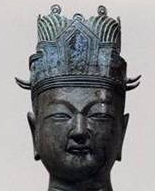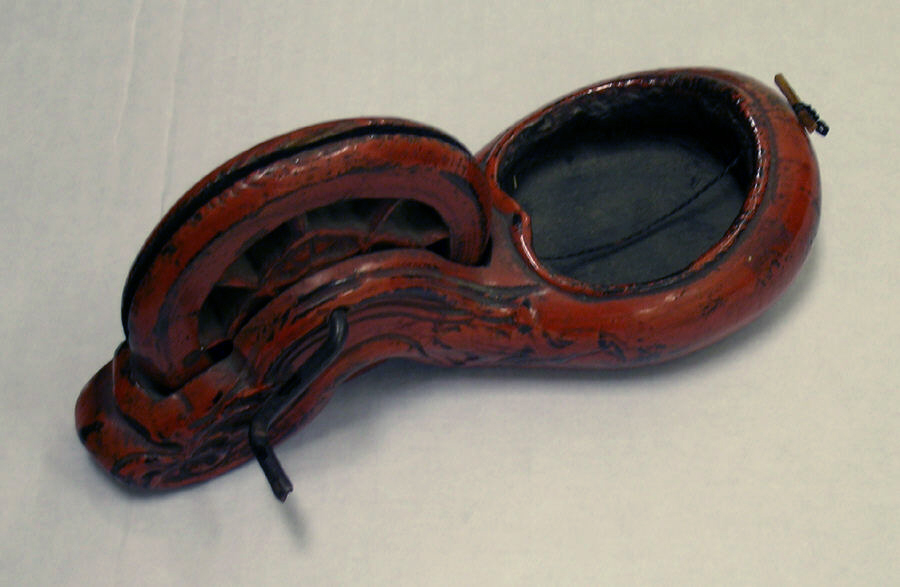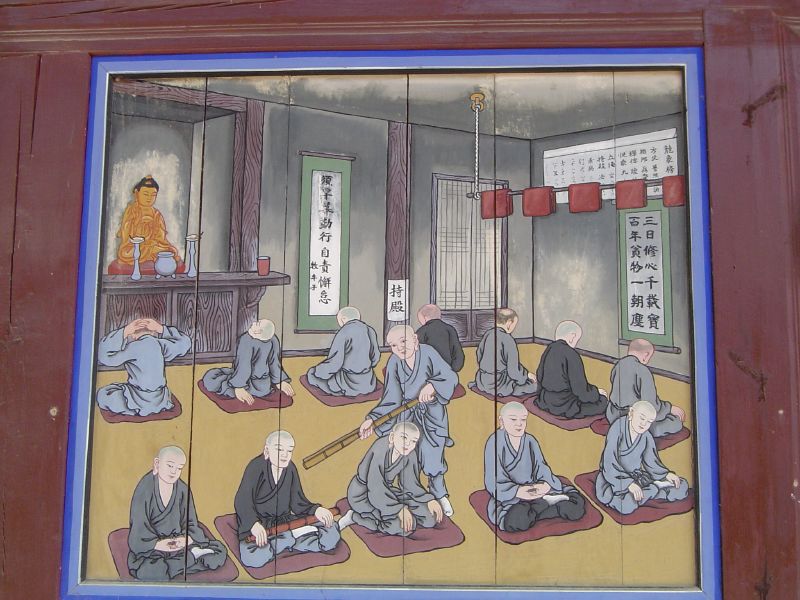|
Jinul
Jinul Puril Bojo Daesa (, "Bojo Jinul"; 1158–1210), often called Jinul or Chinul for short, was a Korean monk of the Goryeo period, who is considered to be the most influential figure in the formation of Korean Seon (Zen) Buddhism. He is credited as the founder of the Jogye Order, by working to unify the disparate sects in Korean Buddhism into a cohesive organization. Biography Bojo Jinul's birthname was Jeong and by age 15 he left his family to be ordained under Seon Master Jonghwi of the Sagulsan School, one of the nine mountain schools of Seon, receiving the ordination name "Jinul". This occurred in 1173. Regarding his training, Buswell observes: "The young monk's relationship with his preceptor does not seem to have been especially close, for his biographer states that he never had a permanent teacher. Chinul's intellect and his natural inclination toward solitude and retreat had been noticeable since his youth; with the fractious climate of the church in his days, he ... [...More Info...] [...Related Items...] OR: [Wikipedia] [Google] [Baidu] |
Korean Seon
Seon or Sŏn Buddhism (; ) is the Korean name for Chan Buddhism, a branch of Mahāyāna Buddhism commonly known in English as Zen Buddhism. Seon is the Sino-Korean pronunciation of Chan, () an abbreviation of 禪那 (''chánnà''), which is a Chinese transliteration of the Sanskrit word of ''dhyāna'' ("meditation"). Seon Buddhism, represented chiefly by the Jogye and Taego orders, is the most common type of Buddhism found in Korea. A main characteristic of Seon Buddhism is the use of the method of meditation, Ganhwa Seon. A Korean monk, Jinul accepted partially a meditative method of Chan Buddhism in 1205. In Chan Buddhism, ''hwadu'' () is a delivery of realising a natural state of the Awakening. Jinul addressed a doctrine of Sagyo Yiepseon () that monks should live an inborn life after learning and forgetting all creeds and theories. Within the doctrine of Jinul, ''hwadu'' is the witnessing of truthful meaning in everyday life. History During the Goryeo dynasty Jinu ... [...More Info...] [...Related Items...] OR: [Wikipedia] [Google] [Baidu] |
Korean Buddhism
Korean Buddhism is distinguished from other forms of Buddhism by its attempt to resolve what its early practitioners saw as inconsistencies within the Mahayana Buddhist traditions that they received from foreign countries. To address this, they developed a new holistic approach to Buddhism that became a distinct form, an approach characteristic of virtually all major Korean thinkers. The resulting variation is called '' Tongbulgyo'' ("interpenetrated Buddhism"), a form that sought to harmonize previously arising disputes among scholars (a principle called ''hwajaeng'' 和諍). Centuries after Buddhism originated in India, the Mahayana tradition arrived in China through the Silk Road in the 1st century CE via Tibet; it then entered the Korean peninsula in the 4th century during the Three Kingdoms Period, from where it was transmitted to Japan. In Korea, it was adopted as the state religion of 3 constituent polities of the Three Kingdoms Period, first by the Goguryeo (also kno ... [...More Info...] [...Related Items...] OR: [Wikipedia] [Google] [Baidu] |
Goryeo
Goryeo (; ) was a Korean state founded in 918, during a time of national division called the Later Three Kingdoms period, that unified and ruled the Korea, Korean Peninsula until the establishment of Joseon in 1392. Goryeo achieved what has been called a "true national unification" by Korean historians as it not only unified the Later Three Kingdoms but also incorporated much of the ruling class of the northern kingdom of Balhae, who had origins in Goguryeo of the earlier Three Kingdoms of Korea. According to Korean historians, it was during the Goryeo period that the individual identities of Goguryeo, Baekje and Silla were successfully merged into a single entity that became the basis of the modern-day Koreans, Korean identity. The name "Korea" is derived from the name of Goryeo, also romanized as Koryŏ, which was first used in the early 5th century by Goguryeo; Goryeo was a successor state to Later Goguryeo and Goguryeo. Throughout its existence, Goryeo, alongside Unified S ... [...More Info...] [...Related Items...] OR: [Wikipedia] [Google] [Baidu] |
Goryeo Buddhist Monks
Goryeo (; ) was a Korean state founded in 918, during a time of national division called the Later Three Kingdoms period, that unified and ruled the Korean Peninsula until the establishment of Joseon in 1392. Goryeo achieved what has been called a "true national unification" by Korean historians as it not only unified the Later Three Kingdoms but also incorporated much of the ruling class of the northern kingdom of Balhae, who had origins in Goguryeo of the earlier Three Kingdoms of Korea. According to Korean historians, it was during the Goryeo period that the individual identities of Goguryeo, Baekje and Silla were successfully merged into a single entity that became the basis of the modern-day Korean identity. The name "Korea" is derived from the name of Goryeo, also romanized as Koryŏ, which was first used in the early 5th century by Goguryeo; Goryeo was a successor state to Later Goguryeo and Goguryeo. Throughout its existence, Goryeo, alongside Unified Silla, was known ... [...More Info...] [...Related Items...] OR: [Wikipedia] [Google] [Baidu] |
Jogye Order
The Jogye Order, officially known as the Jogye Order of Korean Buddhism, (대한불교조계종, 大韓佛敎 曹溪宗), is the leading order of traditional Korean Buddhism, with roots dating back 1,200 years to the late Silla period. Around 820 CE, National Master Doui introduced Seon (Zen in the West) and the teachings of the Sixth Patriarch, Huineng, from China. The order's name, Jogye, originates from the village where Huineng's home temple, Nanhua Temple, is located.(). The Jogye Order rose to prominence in the late 11th century when the monk Jinul combined the direct practices of Korean Seon with the theological foundations of sutra-based Buddhist schools and Pure Land Buddhism. By 1994, the Jogye Order oversaw 1,725 temples, 10,056 clerics, and had 9,125,991 adherents. The international Kwan Um School of Zen, a Jogye school, was founded by Seon Master Seungsahn, the 78th Patriarch, who received dharma teachings from Seon Master Gobong. History The original "Ni ... [...More Info...] [...Related Items...] OR: [Wikipedia] [Google] [Baidu] |
Wisdom Without A Teacher
Wisdom without a teacher (Chinese: 無師智, pinyin: wúshīzhì; Japanese: 無師独悟, mushi-dokugo, Skt. svayaṃbhūjñāna anācāryaka), sometimes also called "self-enlightened and self-certified," or in Japanese, is a term used in Zen Buddhism to refer to the experience of a Zen practitioner reaching enlightenment (bodhi) or kensho without the aid of a master or teacher.Bernard Faure. Visions of Power: Imagining Medieval Japanese Buddhism, page 48, Princeton University Press, 1996Nguyen, T.T.D. (Re-)invented Chan Lineage, Unique Vietnamese Meditation School, or Both? Thích Thanh Từ’s “Revived” Trúc Lâm Tradition of Thiền Tông. ''Religions'' 2024, ''15'', 352. https://doi.org/10.3390/rel15030352 The idea of wisdom without a teacher is often considered suspect among various Zen schools, like in the modern Japanese Sōtō school. William Bodiford writes that since the risk of self-delusion is high, it is common for Zen disciples to rely on their teacher t ... [...More Info...] [...Related Items...] OR: [Wikipedia] [Google] [Baidu] |
Guifeng Zongmi
Guifeng Zongmi () (780–1 February 841) was a Tang dynasty Chinese Buddhist monk and scholar who is considered a patriarch of both the Huayan school and Chan Buddhism. Zongmi wrote a number of works on several Mahayana Sutras, Chan and Huayan, and he also discussed Taoism and Confucianism. His works are a major source for studying the various Chan schools of the Tang. Zongmi was deeply interested in both the practical and doctrinal aspects of Mahayana Buddhism, especially the teachings of the '' Sutra of Perfect Enlightenment'' and the '' Mahayana Awakening of Faith''. Zongmi's work is concerned with harmonizing the various Chan teachings (especially the doctrines of sudden awakening and original enlightenment) with other Chinese Buddhist traditions, especially Huayan, though he also drew on the work of Tiantai Zhiyi in his ritual works. His philosophy attempts to create a comprehensive worldview that includes and sublimates all Buddhist and non-buddhist teachings of his t ... [...More Info...] [...Related Items...] OR: [Wikipedia] [Google] [Baidu] |
Chan Buddhism
Chan (; of ), from Sanskrit '' dhyāna'' (meaning " meditation" or "meditative state"), is a Chinese school of Mahāyāna Buddhism. It developed in China from the 6th century CE onwards, becoming especially popular during the Tang and Song dynasties. Chan is the originating tradition of Zen Buddhism (the Japanese pronunciation of the same character, which is the most commonly used English name for the school). Chan Buddhism spread from China south to Vietnam as Thiền and north to Korea as Seon, and, in the 13th century, east to Japan as Japanese Zen. History The historical records required for a complete, accurate account of early Chan history no longer exist. Periodisation The history of Chan in China can be divided into several periods. Zen, as we know it today, is the result of a long history, with many changes and contingent factors. Each period had different types of Zen, some of which remained influential, while others vanished. Andy Ferguson distinguishes thr ... [...More Info...] [...Related Items...] OR: [Wikipedia] [Google] [Baidu] |
Songgwangsa
Songgwangsa (; translation: Spreading Pine Temple; alternates: Songgwang-sa, or Songgwang Sa, or Songkwangsa; also known as: Piney Expanse Monastery; originally: Gilsangsa), one of the three jewels of Seon Buddhism, is located in South Jeolla Province on Mount Jogye on the Korean Peninsula. Situated approximately away from the sea, it is within the Jogyesan Provincial Park. Founded in 867, it fell into disuse and was reestablished in 1190 by Seon master Jinul. Jinul's meditation teachings evolved from this monastery and contributed significantly to the Seon practice that prevails to this day in Korea. Songgwangsa is considered the "jewel" (''Samgharatna'') of the Korean monastic community. Though smaller in size, it is considered as the greatest among the trio of Three Jewels Temples representing “the Buddha, the dharma, and the sangha". The other two of the trio, Tongdosa and Haeinsa, are located in South Gyeongsang Province. This monastery, though under the jurisdictio ... [...More Info...] [...Related Items...] OR: [Wikipedia] [Google] [Baidu] |
1158 Births
Year 1158 ( MCLVIII) was a common year starting on Wednesday of the Julian calendar. Events By place Byzantine Empire * Autumn – Emperor Manuel I Komnenos sets out from Constantinople at the head of an expeditionary army. He marches to Cilicia; and while the main army follows the coast road eastwards Manuel hurries ahead with a force of only 500 cavalry. He manages to surprise Thoros II "the Great", lord of the Armenian Kingdom of Cilicia, who participated in the attack on Cyprus in 1156. Thoros flees into the mountains and Cilicia is occupied by the Byzantines. Europe * January 11 – Vladislav II becomes king of Bohemia. He is crowned by Frederick Barbarossa, Holy Roman Emperor, with a diadem (called by the chroniclers a ''diadema'' or ''circulus''). Vladislaus is also invested with Upper Lusatia, and accompanies Frederick to Milan to suppress the rebellion in Lombardy (northern Italy). * The Diet of Roncaglia is convoked by Frederick I. He mobilises a ... [...More Info...] [...Related Items...] OR: [Wikipedia] [Google] [Baidu] |
1210 Deaths
Year 1210 ( MCCX) was a common year starting on Friday of the Julian calendar. Events By place Europe * May – The Second Parliament of Ravennika, convened by Emperor Henry of Flanders, is held in the town of Ravennika (in modern Greece), in order to resolve the differences between the princes of Frankish Greece, and the Roman Catholic clergy of their domains. The assembled nobles and prelates conclude a concordat, which recognizes the independence and immunity of all Church property in Frankish Greece from any feudal duties. * ..., which recognizes the independence and immunity of all Church property in Frankish Greece from any feudal duties. * July 18 – Battle of Gestilren">July 18"> ..., which recognizes the independence and immunity of all Church property in Frankish Greece from any feudal duties. * July 18 – Battle of Gestilren: Sverker the Younger, the exiled former King of Sweden, is defeated and killed by the reigning King Erik Knutsson. Af ... [...More Info...] [...Related Items...] OR: [Wikipedia] [Google] [Baidu] |
Korean Philosophy
Korean philosophy focuses on a totality of world view. Some aspects of Shamanism, Buddhism, and Neo-Confucianism were integrated into Korean philosophy. Traditional Korean thought has been influenced by a number of religious and philosophical thought-systems over the years. As the main influences on life in Korea, often Korean Shamanism, Korean Taoism, Korean Buddhism, Korean Confucianism and Silhak movements have shaped Korean life and thought. From 20th century, various Western philosophical thoughts have strongly influenced on Korean academia, politics, and daily life. Three Kingdoms of Korea, Northern and Southern States period, and Goryeo Korean shamanism Taoism Buddhism Korean Buddhist thinkers refined ideas originally introduced from China into a distinct form. The Three Kingdoms of Korea introduced Buddhism to Japan, from where it was popularized in the West. Today, Korean Buddhism consists mostly of the Seon lineage, which is derivative of the Chan (Zen) Budd ... [...More Info...] [...Related Items...] OR: [Wikipedia] [Google] [Baidu] |







